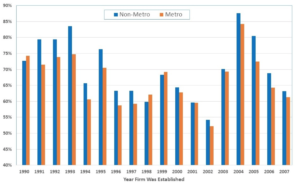A recent article (“Survival Rates of Rural Businesses: What the Evidence Tells Us“) at Choices Online magazine, by Steven Deller and Tessa Conroy, stated that, “Promoting business start-ups and small business activity can stimulate competition and an entrepreneurial spirit within rural communities, which in turn, enhances efficiency, innovation and productivity growth. To succeed, smaller businesses need to be able to adapt to changing environments with flexible production technologies and business strategies. New and small businesses are often a source of experimentation and innovation. By pushing the frontier, they play a vital role in the innovative processes that drive economic growth and development. The importance of business start-ups and a network of smaller businesses to the viability of the local economy has become increasingly recognized by policy makers, as well as rural development researchers and community leaders. Several recent studies have found that start-ups are critical to both gross and net job growth.”
Deller and Conroy noted that, “Not all start-ups or small businesses are innovative—meaning those that bring a new product, process, or service to market. Many start-ups and small businesses are classified as common or reactionary.” The authors explained that, “While community leaders would prefer to foster innovative and high-growth businesses that become a major source of local employment, in rural areas most tend to be characteristically common. Although not necessarily considered as innovative, common and reactionary small businesses can be important to rural communities.”
The Choices article pointed out that, “In rural areas, a small business closure is often quite visible and widely known across the community. Because it is often viewed as a failure, it can create an environment within the community where potential entrepreneurs become risk averse. The local disapproval of failure can discourage risk-taking related to both start-ups and expansion decisions, leading to a stagnant and even declining local economy.”
The authors stated that, “Regardless of designation as either a rural or urban county, between 1990 and 2007, businesses in the typical county had a five-year survival rate of 69% (Figure 1).”

Figure 1. New Business Five-Year Survival Rates. (Source: Calculations based on the National
Establishment Time Series (Choices Online magazine)).
After a closer look at the data, the authors stated that, “In fact, the analysis reveals a survival gradient along the rural-urban spectrum. At the extremes, new businesses in remote small rural areas have a five-year survival rate of 72% which is statistically significantly greater than the largest urban areas where the rate is 67%.”
Deller and Conroy pointed out that, “In urban markets, business owners might be willing to take on riskier business ideas because, if it fails, they can easily try another venture or return to the labor market as a wage-earner. Further, in rural communities where business owners are known figures in the community one’s social standing may be at risk if the business is a failure, particularly if bankruptcy is an outcome.”
The Choices article added that, “In the end, the promotion of entrepreneurial activity at all levels is vital for a dynamic and vibrant local economy whether it be a large urban city or a remote rural village. Communities that foster, nurture and support business at the point of start-ups and those all-important first five years of operation through networking, educational, technical and mentoring services will prove to foster stronger local economies and communities.”

